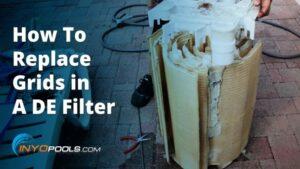The Sandbar is open!
If you’re reading this then there may be a sand berm big enough to threaten shipping lines at the bottom of your pool. Ok, maybe that was a little dramatic, but a dusting of sand around a return line can cause a panic in any pool owner’s mind. Sadly, this is an all too common problem with sand filters but luckily there are some usual culprits that are easy fixes.
Cracked Lateral
If you ask a pool tech about a sandy pool bottom, his first question to you will be, “Did you check for a cracked lateral?” There is a good chance you did not and there are two main reasons why. First, laterals are a pain in the neck to get to, and second most homeowners don’t even know what they are.
Located at the bottom of your filter, this array of 6 – 8 perforated tubes are the last line of defense keeping sand from pouring into your pool. In a sand filter tank, water pours into the sand from the top where it filters its way down through the couple hundred pounds of sand to the bottom of your filter. This is where the little laterals come in. The now filtered water is collected by the laterals and is rushed through the center pipe and and back to the pool. The perforated holes are just big enough to allow water but prevent sand from seeping through.
If there is a crack in one of these laterals sand will find the gap and shoot happily to your pool, to ruin your day. Or at least that’s what it will feel like when you see it pouring into your pool.
The hard part is figuring out it was the laterals, the easy part is actually fixing the problem. For step by step by step instruction, review our guide How To Replace a Lateral in a Pool Sand Filter.
Did You Know?
Sand will leave a telltale streak pattern on the pool floor around the return line. If your pool has a wide dispersal of sand then it may be getting in your pool from an outside source.
Spider Gasket
A multiport valve is like a highway interchange for your water as it routes and diverts the flow to achieve your desired setting. If water is flowing from the waste line when it is not supposed to be then the spider gasket has likely gone bad. Shaped like a wagon wheel, this gasket seals the diverter to the base of the valve preventing leaks into unselected portholes. If the water is allowed to leak into unintended ports then it may accidentally backwash debris and sand into your return.
The spider gasket wears out depending on use and water chemistry. Hard water is hard on rubber. Also, always turn your multiport’s selector handle in the same direction, whether it is clockwise or counterclockwise. If the handle is turned both ways it is more likely to warp the gasket or unseat it from its groove.
For step by step by step instructions, review our guide How To Replace a Spider Gasket on a Multiport Valve.
Don’t Be Dense, Please Rinse.
Would you take a shower by soaping up, then lathering your hair with shampoo just to turn off the water and walk out before rinsing it off? No, I did not think so. The same principle goes for washing out your sand filter. When a filter is backwashed, it is an absolute must that it be rinsed before returning to normal filtering mode.
During backwashing the water’s normal flow is reversed to flush out or loosen heavy dirt particles that clog the filter. Once the backwash is done those particles are deposited in the lines of the filter for the Rinse. If the rinse step is skipped after the backwash all that dirt and nasty stuff goes right back into your pool. Don’t be dense, please rinse.
Can’t Teach Old Sand New Tricks
If you take sand down to its singular property, it is just tiny grains of sediment and when enough is clumped together, it makes one heck of a filtering media. The bad thing is that, just like the three month old milk in the fridge, it has an expiration date. Sand can last approximately 3-5 years in a filter before it needs to be changed. A sign of sand turning is usually high pressure that does not subside even after a repeated backwashes. A signifier that goes along with that symptom is fine sand at the bottom of the pool.
Like water does to large rocks in a river, it smooths and wears down the size of the sand granules. Eventually this wearing gets the sand down to a size where it small enough to fit through the perforated holes in the laterals. Next stop is the bottom of your pool. If your sand has been filtering for a few years and there is returning sand to your pool in congruence with high pressure, this may be the cause.
As usual our pool techs have a guide covering the steps to replacing your sand. If there are some steps you’re fuzzy on, check our How To Change Sand In a Sand Filter guide.













Leave a Reply